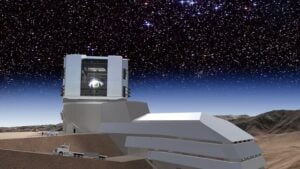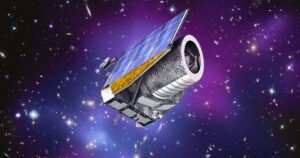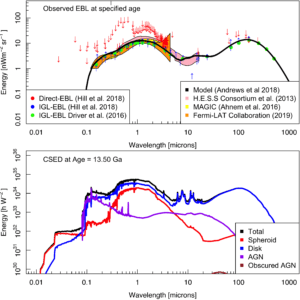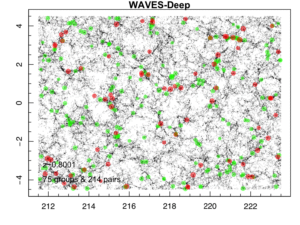Over the past 13 billion years the dark matter and atoms have been forged by gravity into a variety of structures (galaxies, groups, filaments), comprised a variety of mass forms (dark matter halos, stars, gas, dust, super-massive black holes), and produced a significant amount of energy (predominantly starlight and active galactic nucleus [AGN] light). Within the Distant Universe group we are attempting to build the empirical record of how mass has transformed, how energy is produced and how structure has emerged from a smooth distribution of atoms to the myriad of filaments, groups, and galaxies we see today.
To do this we use data from the worlds leading ground and space-based telescopes which include: eROSITA, GALEX, HST, VST, VISTA, WISE, HERSCHEL and very soon the Australian Square Kilometer Array Pathfinder located in Western Australia, the Euclid, JWST and Roman space telescopes and the upcoming LSST facility.
The team at UWA consists of more than eight researchers working on various aspects of this project including: group and filament finding, structural analysis (bulge-disc decomposition) of galaxies, measuring and modelling the energy outputs, quantifying the various mass components (gas, stars and dust), comparing to numerical and hydro-dynamical simulations, and preparing for the next generation spectroscopic campaigns: GAMA, DEVILS, and WAVES.
Prospective students are sought to join the project and potentially work on any aspect of this program. The student will be trained in observational cosmology, galaxy fundamentals, and rigorous statistical analysis of big data sets (a generic 21st century skill). The work will include the use of extensive databases, development of sophisticated software pipelines, advanced visualisation methods, and image analysis and prepare the student for a career in Astronomy or in the Big Data and information sectors.
The student will also be expected to participate in observing runs at remote telescope locations inside and outside of Australia, processing of space satellite imagery, and become part of the extended GAMA, DEVILS and WAVES teams which now includes over 100 researchers across 30 countries and 4 continents.
Particular projects includes:
- DATA FUSION: The Euclid space telescope will launch on 2023 and the Vera Rubin Large Survey of Space and Time will commence late 2024. Two students are needed to work with these new facilities and their data and to fuse them in with our existing database. With Euclid we will take advantage of the high, Hubble Space Telescope-like, resolution to study the emergence of galaxy structures over the past 8 billion years. How have galaxy bulges and discs evolved (mass-size relations, mass distributions, frequencies, star-formation rates etc), how does this compare to very nearby and very distant data (from JWST). Can we determine the dominant physical processes that give rise to each structure and weave together their origin story. With LSST we look to use the data for distance estimates for our 100 million galaxy catalogue, as well as search for hidden galaxy populations, intra-halo light and other sources of light not yet accounted for. Combined we plan to build spectral energy distribution measurements for the 1.8 million galaxies we will observe with 4MOST, to study their energy production from X-ray through optical and near-infrared to mm and radio wavelengths and over all time.


- Modelling Energy Production: One student is needed to help develop new energy production models based on our in-house ProSpect code. The goal is to understand the energy output of galaxies as a function of wavelength from X-ray to radio) and time (13Gyrs to the present day). A important goal is to understand and explain the extragalactic background light (the reason why the sky is not entirely dark at night), and its sub-division into redshift slices. When did the Universe produce the most energy, why and how? Here we look to produce a fully consistent model capable of describing the complete energy output of the Universe since the Big Bang phase and which includes star-formation, AGN activity (including x-ray and radio emission) and dust reprocessing. The modelling team will work closely with the data fusion team.

This image shows our current measurements and modelling of the extragalactic background light (all energy integrated over all time) and the energy being generated by the Universe today (lower panel) and broken into spheroids, discs, AGN and obscured AGN. As well as improving the data and models we now wish to extend to shorter (UV & x-ray) and longer wavelengths (sub-mm & radio). (movie).
- Mapping the Dark Matter: One student is needed to help with measuring and modelling the evolution of the Dark Matter with time. This project makes use of our leading spectroscopic surveys which are designed to be highly complete and optimal for identifying galaxy pairs and galaxy groups (aka Dark Matter Haloes). The velocity dispersion of the groups allow us to measure the underlying dark matter and hence by building galaxy group catalogues in different redshift slices we are able to build up an accurate picture of the evolution of the dark matter over the latter half of the age of the Universe. This project is ongoing in the form of the GAMA and DEVILS surveys and over the next five years we lead the main study of this kind which will be conducted on the newly constructed European Southern Observtory’s 4MOST facility in Chile.

This image shows a screen shot of the underlying dark matter distribution (black dots) and our ability to measure it using galaxy (green) and galaxy groups (red). Using the WAVES Deep survey we will map the dark matter within a 50 square degree region from redshift 0.8 to the present day (a timeline of roughly 8 billion years). (movie).
Other projects include the study of galaxy merger rates, group dynamics, filament finding, and testing Cold Dark Matter simulations. Previous students are either engaged in permanent positions in astronomy research around the world, working in sectors which support this research, or are working in industry applying their statistical analysis skills in diverse areas (from malaria research to cancer research, hedge-fund management, weather forecasting, and the civil service).
If you are interested in these projects or similar, get in touch via simon.driver@icrar.org